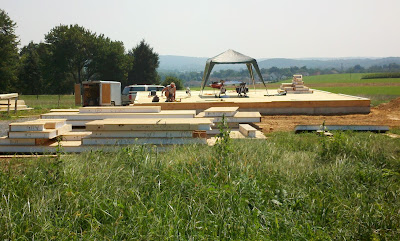Anyone who knows me well knows that I care a great deal about the environment. Hence, I mostly avoid using Styrofoam when I can. I realize it has many wonderful uses, but I believe we use it way too casually. It is not a good candidate for recycling, even if you can find a place to do so. So we drink our take-out coffee and take home our doggie bags, while our landfills fill with plastic puffy stuff that will outlast all of us. In order to do my part to reduce Styrofoam use, I go to the extreme of carrying my own containers to restaurants to take my leftovers home. A little eccentric, but satisfying.
Why am I telling you this? Well, let me start at the beginning. Many months ago, when Eric started making a list of supplies we would need, one of the things he listed was sheets of 3-inch Styrofoam. This was for insulating the inside of the crawlspace wall. One layer of Styrofoam and one layer of drywall. We need insulation because the crawlspace will be heated/air-conditioned (since the ductwork and some of the plumbing will be there). We chose the Styrofoam/drywall solution based on the lower cost, as many of our decisions for this project are. Of course, my first reaction was Styrofoam!? But I bowed to the wisdom (and thriftiness) of the choice.
Way before we started construction, we started scanning the paper and Craig’s List for used items. Last year Eric discovered someone selling second-hand Styrofoam from a factory demolition. How could I refuse! It was half-price, thus saving us even more money. Plus, we wouldn’t be using any new Styrofoam. Yay! I could use it with a clear conscience.
However, transporting it wasn’t easy, so we tied it up in the back of the pickup truck (did we tell you we bought a junker pickup for $1100? We call it Mr. Rattles). Unfortunately, as you know, Styrofoam is very light, and on the way, some of it got caught by the wind and blew off the truck. We collected it all, but by the time we got to the storage locker, some of the pieces were broken and some had been run over by passing vehicles, so had tire marks on them.
Fast-forward to July. It’s time to glue the Styrofoam in, and the broken pieces have to be fitted back together, and we have to figure out how it will fit around all the walls. Eric said, “This is a perfect job for you,” because I like to do puzzles, and he doesn’t. So Ms Anti-Styrofoam spent a week organizing, carrying, cutting and gluing Styrofoam. Probably more Styrofoam than I have saved, pound for pound, in my entire life! (Which made me question the value of my anti-Styrofoam activities) Actually, it was kind of fun. Most of the pieces were intact, and it was just a matter of cutting them to fit the walls.
The whole pieces were eight feet long, but much higher than we needed, so I had to trim them to fit. (Got a nasty blister on my finger from cutting them!) And there were shorter and broken pieces, too, as you can see.
I spent one morning mixing and matching the broken pieces until I could see where they fit together. Once I figured out where each piece was going to go, I started gluing them up. Unfortunately, it’s been a rainy year. So I’d glue some down, go away till the next day, and it would rain. When I’d come back the next day, some of them would’ve fallen down. Arrrrrgh! I finally got them all up, with the backers nailed into place.
Ah…the backers. In between the pieces of Styrofoam you have to put wooden backers, so you’ll have something to nail the drywall to. And how, you might wonder, do you nail pieces of wood into concrete blocks? With a Ramset. A Ramset is an awesome gun that shoots nails into the wall. You load a nail onto the end of the gun, then you put a (small) bullet into a little chamber. Then you position your gun and hit the end of it sharply with a hammer, and BAM, your nail gets forced into the wall. Very noisy (yes, I wore ear protection), and kind of tedious, since you have to load each nail and bullet separately, but very cool. This project is constantly reminding me of how clever people are for thinking up tools to do specific jobs perfectly. Forget “There’s an app for that.” My new phrase is “There’s a tool for that? Cool!”
So the Styrofoam is up, and here’s a picture of a finished wall. It’s braced until the glue dries.
We will put the drywall up after the house is under roof, so that it won’t get wet. Of course, this means we’ll have to nail the drywall up while sitting in a 36-inch crawlspace. Oh, well. There are lots of tasks where you think, “I don’t want to do that,” and then you do it anyway, because you have to. I’m glad this one is done!

































